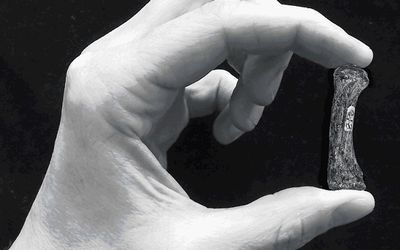FROM holding a hammer to tweezing out a splinter, human hands have fuelled our success as a species. But exactly how and when our ability to manipulate tools evolved has puzzled scientists for decades.
New research on fossils from the Cradle of Humankind, published on Thursday in the journal Science, has raised the possibility that our ancestors may have had the capacity to use stone tools more than half a million years before the oldest known stone tools were made.
Until now, scientists have largely assumed the first hominin toolmaker was the "handy man", Homo habilis, who used stone tools that have been dated back to about 2.6-million years ago.
But a team of scientists led by Kent University palaeoanthropologist Matthew Skinner now suggests a much earlier human ancestor called Australopithecus africanus, who lived in SA 3.2-million years ago, had hands that could grip and press objects such as stone tools.
"Our evidence is consistent with the idea that Australopithecines could have forcefully gripped something like a stone flake to cut meat or process hard fruit skin. We didn’t expect this. People tend not to associate Australopithecines with tools," said Dr Skinner.
His team used a high-resolution CAT scanner to analyse A. africanus fossils from the Sterkfontein caves and earlier hominin fossils from the Swartkrans site. "The really exciting thing about this research is that it studies the internal, spongy bone of the hand, which remodels and changes shape in response to the force placed on it," said Dr Skinner, who is also an associate of the Institute for Human Evolution at the University of the Witwatersrand.
"If you just study the external shape of bones you can only guess that an individual was capable of a behaviour, you don’t know if they were actually doing it," he said.
The team studied the distribution pattern of what is known as "trabecular bone", a porous honeycomb-like tissue inside bones that reforms in response to stress. Parts of the hand with a higher density of trabecular bone indicate areas that are subjected to more force, which offers insight into what the hands were used for, said Dr Skinner. Hands used to hang from branches or for knuckle-walking develop a trabecular bone density pattern quite different from hands used for holding objects like stone tools.
Dr Skinner’s team analysed the trabecular bone density in human, chimpanzee and gorilla hands, and that of fossils belonging to Neanderthals, A. africanus and A. robustus. They found the distribution of trabecular bone in A. africanus and the other South African hominins was similar to that of "committed tool makers" such as Neanderthals and early Homo sapiens.
His team was only able to study parts of fossilised hands. Next, they hope to study a more complete specimen, that of A. sediba, discovered by Lee Berger five years ago.

An example of a human precision grip, grasping the first metacarpal bone of the thumb of an Australopithecus africanus, 3.2-million years old. Picture: T KIVELL AND M SKINNER
FROM holding a hammer to tweezing out a splinter, human hands have fuelled our success as a species. But exactly how and when our ability to manipulate tools evolved has puzzled scientists for decades.
New research on fossils from the Cradle of Humankind, published on Thursday in the journal Science, has raised the possibility that our ancestors may have had the capacity to use stone tools more than half a million years before the oldest known stone tools were made.
Until now, scientists have largely assumed the first hominin toolmaker was the "handy man", Homo habilis, who used stone tools that have been dated back to about 2.6-million years ago.
But a team of scientists led by Kent University palaeoanthropologist Matthew Skinner now suggests a much earlier human ancestor called Australopithecus africanus, who lived in SA 3.2-million years ago, had hands that could grip and press objects such as stone tools.
"Our evidence is consistent with the idea that Australopithecines could have forcefully gripped something like a stone flake to cut meat or process hard fruit skin. We didn’t expect this. People tend not to associate Australopithecines with tools," said Dr Skinner.
His team used a high-resolution CAT scanner to analyse A. africanus fossils from the Sterkfontein caves and earlier hominin fossils from the Swartkrans site. "The really exciting thing about this research is that it studies the internal, spongy bone of the hand, which remodels and changes shape in response to the force placed on it," said Dr Skinner, who is also an associate of the Institute for Human Evolution at the University of the Witwatersrand.
"If you just study the external shape of bones you can only guess that an individual was capable of a behaviour, you don’t know if they were actually doing it," he said.
The team studied the distribution pattern of what is known as "trabecular bone", a porous honeycomb-like tissue inside bones that reforms in response to stress. Parts of the hand with a higher density of trabecular bone indicate areas that are subjected to more force, which offers insight into what the hands were used for, said Dr Skinner. Hands used to hang from branches or for knuckle-walking develop a trabecular bone density pattern quite different from hands used for holding objects like stone tools.
Dr Skinner’s team analysed the trabecular bone density in human, chimpanzee and gorilla hands, and that of fossils belonging to Neanderthals, A. africanus and A. robustus. They found the distribution of trabecular bone in A. africanus and the other South African hominins was similar to that of "committed tool makers" such as Neanderthals and early Homo sapiens.
His team was only able to study parts of fossilised hands. Next, they hope to study a more complete specimen, that of A. sediba, discovered by Lee Berger five years ago.


















 Register for our
Register for our 




Post a comment